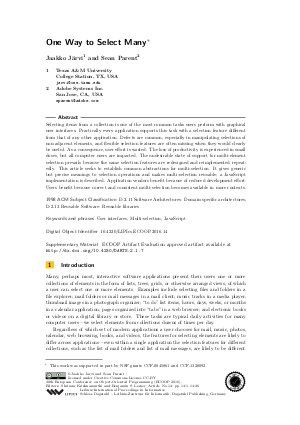One Way to Select Many
Authors Jaakko Järvi, Sean Parent
-
Part of:
Volume:
30th European Conference on Object-Oriented Programming (ECOOP 2016)
Part of: Series: Leibniz International Proceedings in Informatics (LIPIcs)
Part of: Conference: European Conference on Object-Oriented Programming (ECOOP) - License:
 Creative Commons Attribution 3.0 Unported license
Creative Commons Attribution 3.0 Unported license
- Publication Date: 2016-07-18
File

PDF
LIPIcs.ECOOP.2016.14.pdf
- Filesize: 0.81 MB
- 26 pages
Document Identifiers
Subject Classification
Keywords
- User interfaces
- Multi-selection
- JavaScript
Metrics
- Access Statistics
-
Total Accesses (updated on a weekly basis)
0Document
0Metadata
Abstract
Selecting items from a collection is one of the most common tasks users perform with graphical user interfaces. Practically every application supports this task with a selection feature different from that of any other application. Defects are common, especially in manipulating selections of non-adjacent elements, and flexible selection features are often missing when they would clearly be useful. As a consequence, user effort is wasted. The loss of productivity is experienced in small doses, but all computer users are impacted. The undesirable state of support for multi-element selection prevails because the same selection features are redesigned and reimplemented repeatedly. This article seeks to establish common abstractions for multi-selection. It gives generic but precise meanings to selection operations and makes multi-selection reusable; a JavaScript implementation is described. Application vendors benefit because of reduced development effort. Users benefit because correct and consistent multi-selection becomes available in more contexts.
Cite As Get BibTex
Jaakko Järvi and Sean Parent. One Way to Select Many. In 30th European Conference on Object-Oriented Programming (ECOOP 2016). Leibniz International Proceedings in Informatics (LIPIcs), Volume 56, pp. 14:1-14:26, Schloss Dagstuhl – Leibniz-Zentrum für Informatik (2016)
https://doi.org/10.4230/LIPIcs.ECOOP.2016.14
BibTex
@InProceedings{jarvi_et_al:LIPIcs.ECOOP.2016.14,
author = {J\"{a}rvi, Jaakko and Parent, Sean},
title = {{One Way to Select Many}},
booktitle = {30th European Conference on Object-Oriented Programming (ECOOP 2016)},
pages = {14:1--14:26},
series = {Leibniz International Proceedings in Informatics (LIPIcs)},
ISBN = {978-3-95977-014-9},
ISSN = {1868-8969},
year = {2016},
volume = {56},
editor = {Krishnamurthi, Shriram and Lerner, Benjamin S.},
publisher = {Schloss Dagstuhl -- Leibniz-Zentrum f{\"u}r Informatik},
address = {Dagstuhl, Germany},
URL = {https://drops.dagstuhl.de/entities/document/10.4230/LIPIcs.ECOOP.2016.14},
URN = {urn:nbn:de:0030-drops-61080},
doi = {10.4230/LIPIcs.ECOOP.2016.14},
annote = {Keywords: User interfaces, Multi-selection, JavaScript}
}
Author Details
Supplementary Materials
- ECOOP 2016 Artifact Evaluation approved artifact available at https://doi.org/10.4230/DARTS.2.1.7
References
- Apple Computer, Inc. Lisa user interface starndards. Internal technical document, September 1980. URL: https://www.guidebookgallery.org/articles/lisauserinterfacestandards.
-
Apple Computer, Inc. Macintosh Human Interface Guidelines. Addison-Wesley, USA, 1992.

- Apple Inc. Mac Developer Library, 2015. URL: https://developer.apple.com/library/mac/navigation.
- Apple Inc. OS X El Capitan: Select items, 2015. URL: https://support.apple.com/kb/PH21888.
-
Judy Bowen and Steve Reeves. Formal models for user interface design artefacts. Innovations in Systems and Software Engineering, 4(2):125-141, 2008.

-
A. J. Dix and C. Runciman. Abstract models of interactive systems. In HCI'85: People and Computers: Designing the Interface, pages 13-22. Cambridge University Press, 1985.

-
Michael D. Harrison and H. Thimbleby, editors. Formal Methods in Human Computer Interaction. Cambridge University Press, 1990. Chapter 1.

-
John Karat, James E. McDonald, and Matthew P. Anderson. A comparison of menu selection techniques: Touch panel, mouse and keyboard. International Journal of Man-Machine Studies, 25(1):73-88, 1986.

- Shriram Krishnamurthi, Robert Bruce Findler, Paul Graunke, and Matthias Felleisen. Interactive Computation: The New Paradigm, chapter Modeling Web Interactions and Errors, pages 255-275. Springer, Berlin, Heidelberg, 2006. URL: http://dx.doi.org/10.1007/3-540-34874-3_11.
- Jonathan Lazar, Adam Jones, Mary Hackley, and Ben Shneiderman. Severity and impact of computer user frustration: A comparison of student and workplace users. Interacting with Computers, 18(2):187-207, March 2006. URL: http://dx.doi.org/10.1016/j.intcom.2005.06.001.
- Microsoft. Select multiple files or folders. MS Windows support topic. Accessed: 2015-11-31. URL: https://windows.microsoft.com/en-us/windows7/select-multiple-files-or-folders.
-
Microsoft. Windows Interface Guidelines for Software Design. Microsoft Press, Redmond, WA, USA, 1st edition, 1995.

- Oracle. JavaFX, MultipleSelectionModel. Accessed: 2015-12-07. URL: https://docs.oracle.com/javase/8/javafx/api/toc.htm.
-
Sven Strothoff, Wolfgang Stuerzlinger, and Klaus Hinrichs. Pins 'n' touches: An interface for tagging and editing complex groups. In Proc. of the 2015 Int. Conf. on Interactive Tabletops &Surfaces, ITS '15, pages 191-200, New York, NY, USA, 2015. ACM.

- The jQuery Foundation. jQuery user interface. Accessed: 2015-12-03. URL: https://jqueryui.com.
- The Qt Company. Qt Documentation. Accessed: 2015-12-03. URL: https://doc.qt.io.
-
Weishi Zhang. Formal description and development of graphical user interfaces. Utz, 1996.

